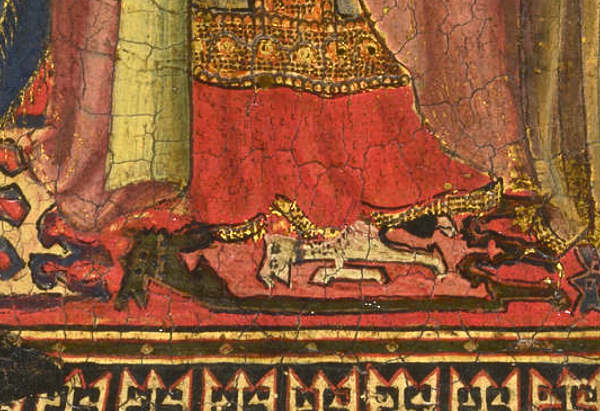Hi all,
As already mentioned, it is rather puzzling that the spectacular extant rugs featuring an «animal-inside-another-animal»,
[ illustrated in the essay: FIG 25 owned by MET and FIG 26 published by H. Kirchheim (1)], would never have caught the eye of any Renaissance painter. True, various sources (2) have mentioned a painting by Gregorio di Cecco (National Gallery, London), featuring such a rug, but the low-definition pictures available on the net did not allow me to verify this information

.
Well, until I finally got the one below(a):
FIG a)

FIG b)

A comparison with the MET rug (b), allows to identify a similar «animal-inside-an-animal» motif. Both feature a wide open mouth and a raised paw. In the MET rug the "adult" beast raises a paw, while in di Cecco’ rug the "baby" does it. Di Cecco’s beasts seems to be spotted, a panther perhaps.
The border is clearly visible and, imho, coherent with a Seljuk identification.
Thus, although the painting is dated from about 1410, the rug featured might be much older, perhaps even contemporaneous to both extant ones : The «Kirchheim rug» is dated by the C14 method between 1190 and 1300 and the MET rug between 1040 and 1290, with 95% confidence in both cases (3).
At any rate this seems to get rid of the shaky theory (mentioned earlier in this thread) that this particular type of animal rugs was not woven before the ottoman period. In 1300 the Ottoman still were only the rulers of a little Beylyk in northern / central Anatolia.
Kirchheim mentions an interesting anecdote about the relatively recent discovery of both extant rugs (4): Following the violent troubles during Tibet annexation by China, many monks emigrated, taking with them whichever precious objects they could save from the disaster, including both extant «animal-inside-an-animal» rugs. Wenzel (5) mentions as well some 13th-14th century anatolian silk and metal-thread brocades which followed the same route. All appeared on the market a few years later.
How they ended-up in tibetan monasteries in the first place is another fascinating question.
But Kirchheim has a credible theory about the highly surprising state of conservation of the rugs: The main sources of light inside the rooms of tibetan monasteries were candles made with the fat of Yaks. Their greasy smoke deposited a protective layer on the rugs (Se non é vero é ben trovato).
Regards
Pierre
Sources
1) H. Kirchheim, Orient Stars, page 15
2) See for example Heilbrunn’s Timeline of Art, MET, New York.
3) H. Kirchheim, Orient Stars, page 374, note# 318
4) H. Kirchheim, Orient Stars, page 12
5) M. Wenzel, Turkish Textiles, 2002.